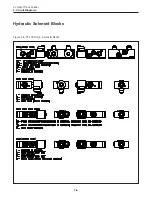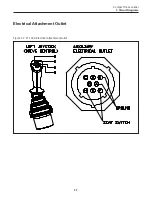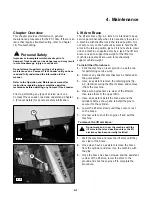
Repair
1.
Disconnect the battery and discharge any capaci-
tor before beginning work on a machine. Attach a
Do Not Operate
tag in the cab to alert any opera-
tor that service is in progress.
2.
If possible, make all repairs with the machine
parked on a level, hard surface. Use blocks to pre-
vent the machine from rolling while working on or
under the machine.
3.
Do not work on or under any machine that is sup-
ported only by a hydraulic jack or hoist. Always
use some sort of mechanical support to ensure
that the machine will not fall. Terex jack stands
work well to support the machine while performing
maintenance or repair work.
4.
Make sure the work area around the machine is
safe and make yourself aware of any hazardous
conditions that may exist. If the engine needs to
be started inside an enclosure, make sure that the
engine’s exhaust is properly vented.
5.
Be sure all protective devices including guards and
shields are properly installed and functioning cor-
rectly before beginning any service task. If a guard
or shield must be removed to perform the repair
work, use extra caution.
6.
Always use the appropriate tools for the work to be
performed. Tools should be in good condition and
you should understand how to use them properly
before performing any service work.
7.
When replacing fasteners, use parts of equivalent
grade and size. Do not use a lesser quality fasten-
er if replacements are necessary.
8.
Be prepared to stop an engine if it has been re-
cently overhauled or the fuel system has been
recently serviced. If the engine has not been
assembled correctly, or if the fuel settings are not
correct, the engine can possibly overspeed and
cause bodily injury, death or property damage. Be
prepared to shut off the fuel and air supply to the
engine in order to stop the engine.
9.
Be careful when removing cover plates. Gradually
back off the last two bolts or nuts located on oppo-
site sides of the cover. Then, pry the cover loose
to relieve any spring or other pressure before
removing the last two nuts or bolts completely.
10.
Repairs requiring welding should be performed
only by personnel adequately trained and knowl-
edgeable in welding procedures and with the guid-
ance of appropriate reference information.
Determine the type of metal being welded and
select the correct welding procedure and filler
material to provide a weld that is as strong or
stronger than the original weld.
11.
Take precautions to avoid damaging wiring during
removal and installation operations. Carefully route
wires so that they will not contact sharp corners,
objects or hot surfaces during operation.
12.
When performing service that requires the lift arms
to be in the raised position, always utilize the lift
arm brace located on the rear of the loader tower.
13.
Relieve hydraulic system pressure by relaxing all
hydraulic actuators prior to attempting any
hydraulic maintenance or repair.
14.
Always tighten connections to the correct torque
specification. Make sure that all shields, clamps
and guards are installed correctly to avoid exces-
sive heat, vibration or unwanted contact between
parts during operation. Shields that protect
exhaust components from oil spray in event of a
line, tube or seal failure must be correctly installed.
15.
Do not operate a machine if any rotating part is
damaged or contacts other parts during operation.
Any high speed rotating component that has been
damaged or altered should be checked for balance
before reusing. Make sure all protective devices,
including guards and shields, are properly installed
and functioning correctly before starting the engine
or operating the machine.
1-3
Compact Track Loader
1. Product Safety
Accidental machine starting can cause injury
or even death to personnel working on a
Compact Track Loader.
As a precaution, disconnect the battery cables from
the battery terminals, tape the battery clamps and
remove the key from the ignition switch prior to per-
forming any service work on a Compact Track Loader.
Place a “Do Not Operate” tag prominently on the
machine to inform personnel that the machine is
being serviced.
Prior to welding, disconnect the following to pre-
vent component damage:
•
Negative battery cable
•
J1/P1 connectors from the ECM (engine)
•
Main controller (machine)
•
Output module (machine)
•
Display (machine)
A proper ground is essential to protect the
machine from damage when welding. Improper
grounding can cause damage to mechanical,
hydraulic and electrical components.
As a precaution, connect the welding ground
clamp as close as possible to the weld area.
NOTICE
Summary of Contents for PT100G Forestry
Page 1: ...PT 100G PT 100G Forestry Part Number 2076 286 Printed 8 10 Service Manual Compact Track Loader...
Page 2: ......
Page 6: ......
Page 12: ......
Page 14: ......
Page 22: ......
Page 40: ......
Page 52: ......
Page 62: ......
Page 66: ......
Page 80: ......
Page 98: ......
Page 102: ......
Page 116: ......
Page 136: ......
Page 138: ......
Page 140: ......
Page 141: ......






































